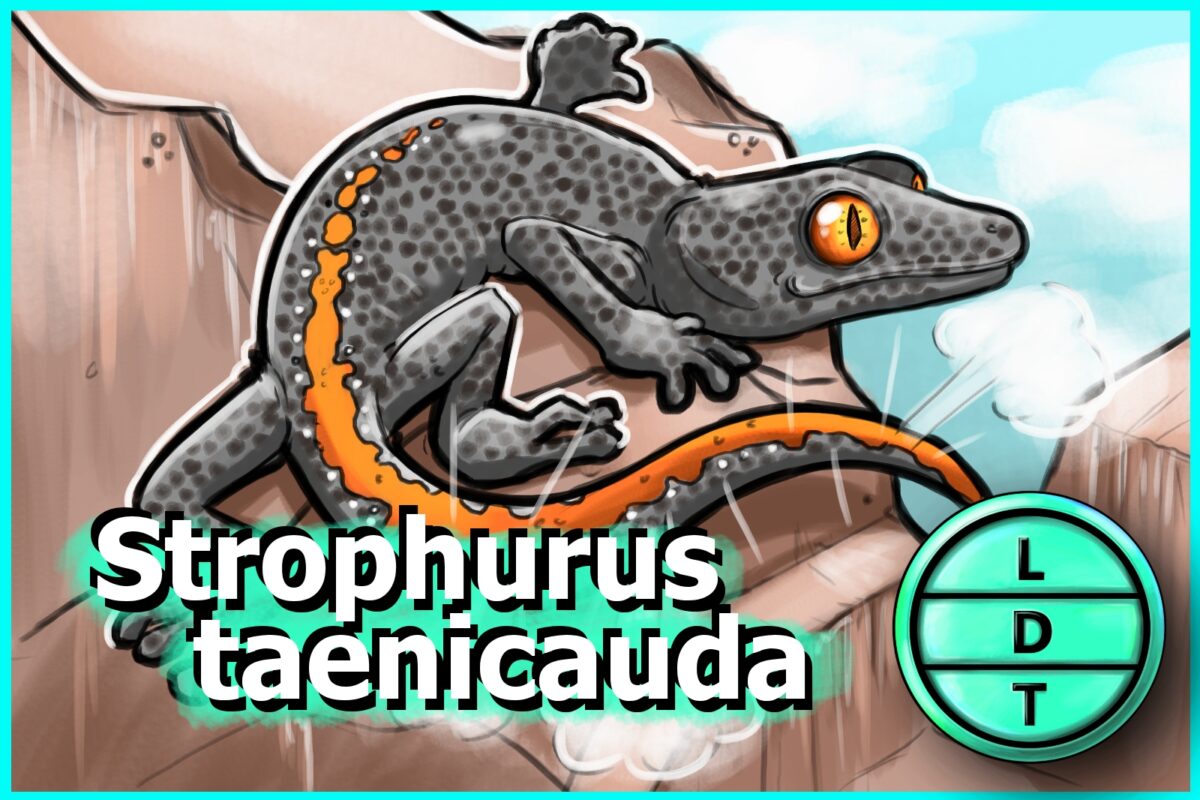“…and today we’re talking about a lizard that is great at getting out of sticky situations. But more on that later.”
In the outback you need an exit strategy for whenever you get into trouble, especially if you’re a lizard of modest stature. The Golden-tailed gecko is a striking subject to look at, but it’s golden tail is more than an interesting feature. When they get into a sticky situation, they’ve learned to fight it by creating their own stickiness. But fighting fire with fire is one way to beat the heat in Life, Death, and Taxonomy.
Description of the Golden-Tailed Gecko
- Really odd and cool looking gecko.
- It’s scales are silver and covered in black spots spots on its scales like a cow or snow leopard
- Its eyes are a burnished bronze/gold
- Its name comes from the fact that it also has a golden stripe extending from the middle of its back to the tip of its tail with the stripe getting wider as it goes.
- Also, as the name suggests, it has spines that go down the ridge of its back and tail
Measure Up
Welcome to the beloved Measure Up segment. The official listener’s favorite part of the show! The part of the show when we present the animal’s size and dimension in relatable terms through a quiz that’s fun for the whole family. It’s also the part of the show that’s introduced by you when you send in audio of yourself saying, singing, or chittering the words Measure Up into ldtaxonomy at gmail dot com. We don’t have a new Measure Up intro but that means we get to hear from an animal and Carlos has to guess what it is.
- Deer
- American Black Duck
- Turkey
- Cod
Length Snout to Vent
- 70mm
- How many golden-tailed geckos go into the distance between the sun and the closest part of the Oort cloud?
- Hint: The Oort cloud is a theoretical region of icy planetesimals that orbit the sun. The oort cloud is proposed to be the origin of many of the icy comets that we see passing through our solar system. The far side of the Oort cloud is more than three light years away.
- 3,885,658,980,000,000 geckos (3.8 quadrillion). The Oort cloud is 2,000 au (0.03 light years).
Weight
- 7 grams (0.2 ounces)
- How many geckos go into the weight of the largest ever turkey.
- Hint: The turkey’s name was Tyson, and he won the largest turkey competition in 1989 in London. At a charity auction that year, he sold for $6,692.
- 5,572 geckos. Tyson weighed 86 pounds.
Fast Facts about the Golden-Tailed Gecko
- Range: Queensland in Eastern Australia. Lives in shrubland and forests
- Diet: Insects
- Behavior:
- Their vision is 350 times better than that of humans and comes complete with night vision
- Lifespan: 4-8 years
Major Fact: The Sticky Sprayer
The Golden Tailed Gecko has a secret stashed away in it’s wonderful golden tail.
When it’s threatened, it rears its tail up and sprays a sticky, foul-smelling substance at would-be attackers.
However, the way they do this is pretty unique. When it comes to sprays and defensive liquids, reptiles typically shoot them from their mouths or, in the case of the horny toad, their eyes. But lizard tails don’t normally have any way to store or spray anything at all.
The sticky liquid isn’t dangerous or toxic, even to the geckos predators, but it does smell and taste foul. Similar to the horny toad’s blood, the foul substance sticks to predators and irritates them while the gecko gets away.
This sticky substance is stored in a series of chambers along the top of the lizard’s tail. The liquid can be expelled through what one paper called a “middorsal rupture zone in the epidermis.” Many species in the diplodactylidae family have this feature.
They can also drop their tails like other lizards, leaving behind that bad tasting snack for an unlucky hunter. However, regenerated stink glands are different from the originals and may not have rupture zones.
Ending: So keep your eyes sharp, become the golden child, and save the smelly stuff for your enemies like the golden-tailed gecko here in Life, Death, and Taxonomy.

